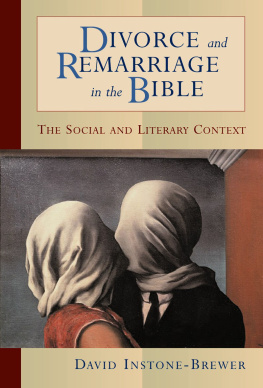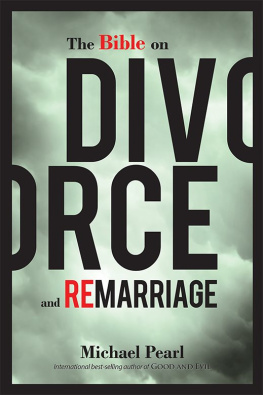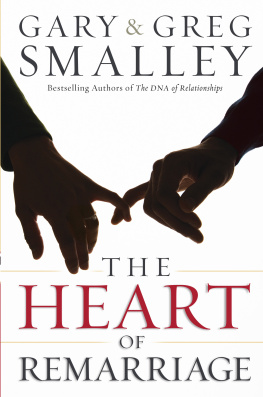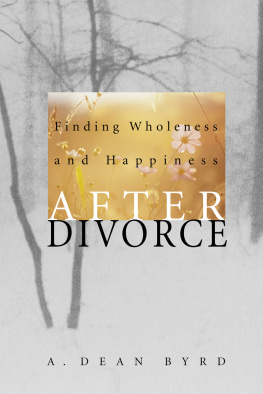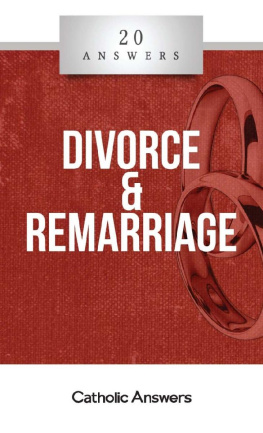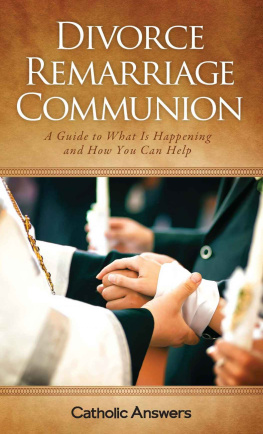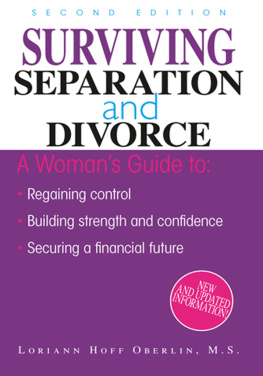

2002 Wm. B. Eerdmans Publishing Co.
All rights reserved
Wm. B. Eerdmans Publishing Co.
Grand Rapids, Michigan
Printed in the United States of America
Library of Congress Cataloging-in-Publication Data
Instone-Brewer, David.
Divorce and remarriage in the Bible: the social and literary
context /David Instone-Brewer.
p. cm.
ISBN 978-0-8028-4943-4 (pbk.: alk. paper)
1. Divorce Biblical teaching.
2. Remarriage Biblical teaching. I. Title.
BS680.D62 I57 2002
241.63 dc21
2001050813
www.eerdmans.com
Contents
Preface
Innumerable scholars and readers have interacted with me in the preparation of this work. Various aspects have been presented at conferences, and the whole of this text has been available, without the footnotes, on my website for several months. The large number of helpful comments and questions, verbally and in emails, has contributed hugely to the development of my ideas and the way they are presented here. Unfortunately I cannot name all those who have helped me, but I would like to mention a few in particular. The members and my fellow minister at Llanishen Baptist Church in Cardiff helped me to consider the practical issues at the heart of this study and encouraged me to find time for research. Later, when I took up a research post at Tyndale House in Cambridge, I was able to interact with a constant stream of doctoral and postdoctoral scholars who visited or stayed there, as well as other scholars who are resident in Cambridge. In particular, William Horbury gave much useful guidance, Gerald Bray helped me with Latin texts, and Bruce Winter introduced me to the complexities of Roman law.
Editing this work would not have been possible without the help of Olaf Olsen, who responded to my appeal on the internet for an editor who would work for nothing more than a free copy of the book. His attention to detail was truly remarkable. My wife was the second editor, who worked just as hard for even less reward.
The frequent emails from people who have read my work in progress on the web have helped me to keep focused on the practical issues. I would like to apologize to the many who have received very brief replies to their requests for pastoral help that I am not able to give. This book is not really for them, but it lays the academic foundations of a practical and sensitive pastoral response for the millions of people who are suffering from the Churchs misunderstanding of this subject.
Introduction
The purpose of this book is to understand the meaning of the New Testament teaching on divorce and remarriage as it would have been understood by its original readers. This is as close as historical research can get to the elusive authorial intent.
The conclusions, in brief, are:
- Both Jesus and Paul condemned divorce without valid grounds and discouraged divorce even for valid grounds.
- Both Jesus and Paul affirmed the Old Testament grounds for divorce.
- The Old Testament allowed divorce for adultery and for neglect or abuse.
- Both Jesus and Paul condemned remarriage after an invalid divorce, but not after a valid divorce.
These conclusions are very different from the traditional Church interpretation of the New Testament texts, which concluded that divorce with remarriage was not allowed on any grounds, and that separation was allowed only in the case of adultery, and possibly desertion by a nonbelieving spouse. The reason for this difference is that the background knowledge and assumptions of a first-century reader were already forgotten by the second century, and thus the texts were misunderstood even by the Early Church Fathers.
In order to understand the New Testament through the eyes of a first-century reader, the historical context and literary background need to be understood in great detail.
There is, of course, no such thing as a typical first-century reader. All readers come to the text with their own presuppositions. This was as true in NT times as now. However, one presupposition was shared by all first-century believers, both Jews and Christians: they all accepted that the Old Testament was Gods word and was the basis for ethics.1 The teaching of the New Testament would be tested against this groundwork. The opening chapters will therefore examine the teaching on divorce and remarriage in the Old Testament.
The first-century readers of the New Testament were not particularly interested in the original meaning of the Old Testament. They considered that God was speaking directly to them and that his words should be interpreted for their own time. The original intent of the words to the original audience of the Old Testament was of little interest to them.2 However, the original intent of the Old Testament is important to the modern reader, if only to prevent us from reading the text through the presuppositions of our own culture. Therefore the cultural context of the Old Testament will be covered as well as the cultural context of the New Testament.
The intertestamental period is important because it helps us to understand the development of the Jewish and Greco-Roman cultures in the first century. We need insights into these cultures in order to understand how the original recipients read the New Testament. The chapters on Jesus and Pauls teaching apply these insights to the New Testament texts.
The later chapters of the book trace the consequences of neglecting the cultural background of the text. The Early Church was soon separated from the Synagogue, and the Jewish world was itself cut off from part of its past by the destruction of Jerusalem. Background knowledge that could be taken for granted in the original readers of the New Testament disappeared from the Church. The misunderstandings that resulted, especially in the teaching on divorce and remarriage, have continued to the present. The final chapter outlines some practical pastoral responses.
In the scholarly world there are no firm conclusions, only theories that are internally coherent and that fit the facts to a greater or lesser degree. The findings that are presented here have already been debated with innumerable scholars at conferences, in journals, over coffee at Tyndale House, and by email. There are many who remain to be convinced, but most have welcomed the clear theology of marriage that results from these conclusions, and the way that they concur with pragmatic common sense, while being based on rigorous historically contextual biblical research.
The tradition of the Church is based on a completely different interpretation. My hope is that this work will give a biblical foundation to Church leaders and individuals who are seeking to evaluate that tradition for themselves.
Further resources are available at my website, www.Instone-Brewer.com.

1. It has been argued that Paul did not base his ethics on the Old Testament. This has been convincingly refuted by Brian Rosner in Paul, Scripture and Ethics: A Study of 1 Corinthians 57, Arbeiten zur Geschichte des antiken Judentums und des Urchristentums 22 (Leiden: Brill, 1994).
2. This does not mean that they were not interested in the context or the plain meaning of the text. In my Techniques and Assumptions in Jewish Exegesis before 70 CE , Texte und Studien zum antiken Judentum 30 (Tbingen: J. C. B. Mohr, 1992), I show that rabbinic Judaism in New Testament times took the context into account and always pursued the primary meaning of the text, though their idea of the primary meaning may often have been different from ours. The more extreme midrashic techniques such as lifting the text out of its context and looking for multiple layers of meaning came to rabbinic Judaism after 70 C.E. via Alexandria and Qumran, where they were already being employed in New Testament times.
Next page
